| Your Mac's hard drive is one of its most important devices, and its performance and operation have a major impact on the performance and operation of your system. At some point, you will probably want to increase the amount of hard disk space available to you. Adding more hard drive space is relatively simple in most cases and offers many benefits to you. Choosing a Hard Drive When it comes to choosing a hard drive, you should consider the following factors: Will your Mac support additional internal hard drives? If you use a Power Mac G5, Power Mac G4, or other desktop Mac, the answer to this question is yes. If you have an iMac, an eMac, a Power Mac G4 Cube, a PowerBook, or an iBook, the answer is no. Should you add an external drive? If your Mac won't support the addition of another internal hard drive, you will likely want to add more hard drive space by using an external hard drive. Even if your Mac can handle an additional internal hard drive, you might choose to get an external drive instead because external drives are simpler to install and easier to use with different machines. For example, you can share the same external hard drive among several Macs. Because FireWire offers acceptable performance for all but the most demanding tasks, you won't face much of a performance penalty if you choose to use an external hard drive. Which drive interface does your Mac use? For internal drives, the choices are ATA or SCSI. For external drives, the choices are FireWire, FireWire 800, USB 2, or SCSI. NOTE Some external hard drives use the USB 2 interface, which is a dominant interface on Windows computers and is supported on some Mac models. However, in most cases, FireWire external drives should be your first choice. FireWire (both varieties, but especially FireWire 800) offers excellent performance and you won't have to use a USB port on your Mac (which is good because you tend to need more USB ports than FireWire ports).
What size drive do you need? Drives come in various sizes; generally, you should get the largest drive you can afford in the format you select. Does your Mac need to meet specific performance requirements? If you intend to use the drive for high data rate work, such as for digital video, typically, you need to get a drive that spins at least 7,200rpm. Some drives spin even faster, which means they can transfer data at a greater rate. (Some drives that spin at slower rates are also acceptable; check with the drive's manufacturer to see what data rate the drive can sustain.)
NOTE If you have a Mac with room for only one internal hard drive, you can replace that drive with one of a higher capacity. For PowerBooks and iBooks, this is a relatively simple operation. For iMacs, this is a more complex task and is not recommended unless you are very comfortable working with hardware.
 To learn about the various interfaces related to hard drives, p. 815. To learn about the various interfaces related to hard drives, p. 815.
After you have answered these questions, you should have a good idea about the type of drive you need, such as an external FireWire hard drive that offers performance suitable for DV work and has as much space as you can afford to purchase. Head to your favorite retail site to research or purchase hard drives (see Figure 31.1). Figure 31.1. Check out this LaCie 500GB drive that supports both flavors of FireWire, which means it is compatible with all modern Macs. 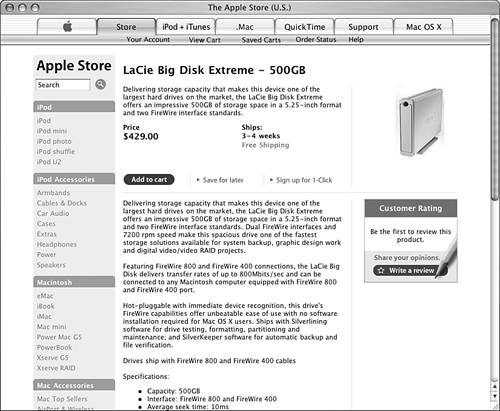
CAUTION Before you purchase a drive, check the owner's manual for your Mac to ensure that the specifications for the drive are compatible with your Mac.
To begin using a drive, you must install the drive, and then initialize and partition it. Installing an External Hard Drive Installing an external hard drive is about as simple as things get. You connect the power supply to the drive and to an electrical outlet, if needed (some drives take their power from the interface). Then, you connect the FireWire, USB 2, or SCSI cable to the drive and your Mac. If you install a SCSI drive, you must make sure that it has a unique SCSI ID number for the external SCSI bus to which you are attaching it. You also need to ensure that the drive is properly terminated. (Most modern Macs require a SCSI PCI card to be added to be capable of using external SCSI drives. Unless you specifically need SCSI for some reason, a FireWire drive is a better choice.) After you have connected the drive and powered it up, the installation part is complete (easy installation is a good reason to use an external drive).  | If you're having trouble getting your Mac restarted after connecting a SCSI drive to it, see "My Mac Won't Start Up After I Connect a Drive to It" in the "Troubleshooting" section at the end of this chapter. |
 For more information about SCSI, p. 833. For more information about SCSI, p. 833.
CAUTION Remember that SCSI devices, unlike FireWire or USB devices, are not hot-swappable. You must power down your system before adding or removing a SCSI drive.
Installing an Internal Hard Drive Installing an internal hard drive is a bit more complicated than installing an external drive, but it is still relatively easy to do. NOTE Because I don't recommend that most users replace a hard drive in most Macs, this section provides information only on adding additional hard drives to a Power Mac G4 or Power Mac G5. If you are comfortable enough working inside a Mac to be able to replace a hard drive, you probably don't need any help doing so. The following steps describe how to install an internal ATA drive in a Power Mac G4. Installing a SCSI drive is similar, although it uses the SCSI interface and cables rather than ATA cables as this example shows. These steps are provided only as an example; you should follow the instructions provided with your Mac.
Before you get started, read through the instructions contained in your Mac's user manual. Then do the following: 1. | Get the drive ready to install by configuring it as a slave drive (if necessary); see the instructions that came with the drive for help with this. Typically, this involves configuring jumper clips on specific pins at the back of the drive (see Figure 31.2). Most of the time, these pins are already set in the appropriate configuration.
Figure 31.2. This photo shows the back of a hard drive; the jumper clips are configured to make this drive the slave. 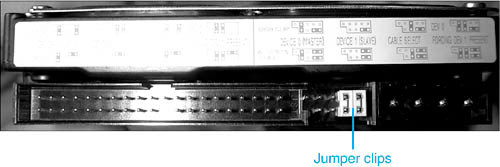
| 2. | Back up the data on your Mac (just in case).
| 3. | Power down your Mac.
| 4. | Open the case.
| 5. | Locate the bay in which you are going to install the drive; in Power Mac G4s, this bay is located at the bottom of the machine toward the back (see Figure 31.3).
Figure 31.3. The hard drive that came with this G4 Power Mac is installed in the lower part of the drive carrier located in the drive bay; an additional drive can be added to the upper part of the carrier. 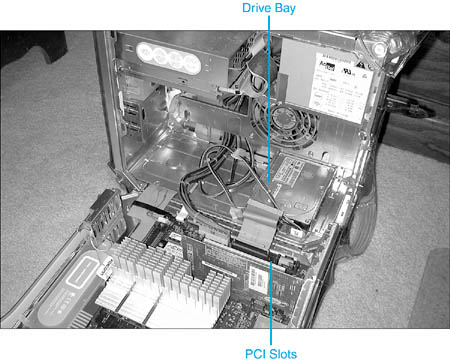
| 6. | Unplug the power cable from the motherboard and the data and power cables from the existing drive.
| 7. | Remove the screw that holds the driver carrier in place.
| 8. | Install the new drive in the upper part of the drive carrier; use the screws that were included in the accessory kit that came with your Mac.
| 9. | Install the drive carrier back in the Mac.
| 10. | Connect the power and data cables to each drive.
| 11. | Reconnect the power cable to the motherboard.
| 12. | Close the Mac and power it up.
|
The Mac should restart normally. When it boots up, you won't notice any difference because you can't use the drive until you initialize it. Initializing and Partitioning a Hard Drive Before you can use a hard drive, whether it is internal or external, you should initialize it (you have to initialize an internal drive before you can use it, but most external drives can be used out of the box). You can also partition a hard drive to create multiple volumes on a single drive (for example, you might want to be able to install more than one version of the Mac OS on a single disk). When you partition a hard drive, logical volumes are created for each partition on the disk. For most practical purposes, a logical volume looks and acts just like a separate hard drive. There can be some small performance advantages to partitioning a disk, or you might choose to partition it to help you keep your system organized. The most likely reason to partition a drive is to be able to run more than one version of the Mac OS on your computereach version needs to be installed on a separate volume. One of the results of partitioning a drive is that all the volumes outside of the startup volume are outside of the default Mac OS X organization scheme. This can be a benefit or a problem depending on what you are doing. For example, documents you store on a separate volume aren't secured using Mac OS X's default permissions, like documents you store within your Home folder are. If you want to provide broader access to files, this is a good thing. If you don't want people to be able to access these documents outside the control of Mac OS X's security, it isn't. Be aware though that when you partition a drive, the size of each partition becomes a size limitation, just as if the volume was a separate disk. If your partition sizes are too small, you might run out of free space in a specific volume even though the disk on which that volume is stored still has plenty of space. Generally, you should keep your partitions pretty large. If you run out of space on a partition, you have to delete files from it or re-partition the disk, which means that you must start over and reformat the disk (resulting in all files being erased). Unless you have a very specific reason to do so, you typically shouldn't partition a drive into more than two volumes. If you aren't going to have multiple versions of the Mac OS installed, you might not want to use multiple partitions at all. How Many Partitions? Because the size of a partition can't be changed without erasing the disk on which it is stored, you should avoid creating partitions unless you have a specific reason to do so. The size of a partition becomes a space limit just as if it were a disk. Because erasing and recovering all the data on a drive isn't a lot of fun, don't set yourself up to have to do it by creating small partitions. I recommend that you do have at least two volumes available to you, and it is even better if you have these on more than one drive. Then, install a version of Mac OS X on each volume. One should be your primary startup volume on the internal disk in your Mac. Create a small (10GB or so) partition on a different disk (or the same one if you have only one drive available to you) and install Mac OS X on it. Keep this as an alternative startup volume in case your main startup volume has problems. An ideal configuration is to have at least one external drive along with your Mac's internal drive. Have only one partition on the internal drive and make that your startup volume. This ensures you have as much storage space on that volume as possible. Partition the external drive into two volumes, one relatively small (10GB) and the other with the remainder of the drive's space. Install your alternative OS installation on the smaller volume. Use the large partition for data storage, such as for backups. |
NOTE Most external hard drives come initialized, in which case you can use them without doing the following steps. However, even in those cases, you might want to partition the drive, especially if it is a large one.
To initialize and partition a disk, perform the following steps: 1. | Launch Disk Utility (Applications/Utilities). In the Disk Utility window, you will see two panes. In the left pane, you will see the drives installed in your system (the drives are labeled by their capacities and types). Under each disk, you'll see the volumes into which that disk has been partitioned.
| 2. | Select the drive with which you want to work. At the top of the right pane are five tabs; each tab enables you to view data about a drive or to perform a specific action. At the bottom of the window, you'll see detailed information about the drive with which you are working, such as its connection bus, type, capacity, and so on (see Figure 31.4).
Figure 31.4. The Source pane of the Disk Utility application shows two hard drives, and one external FireWire drive, which has been selected (information about the drive appears at the bottom of the window). 
| 3. | Click the Partition tab. In the left part of this pane, you'll see a graphical representation the partitions on the disk. If the disk is currently partitioned, you'll see its current partitions. If you are working with a new disk, you'll see one empty partition called "Untitled." In the right part of the pane, you'll see information about the volume, such as its name, current format, and size.
NOTE Another reason you might want to partition a hard drive is to more easily share files with other users of your Mac. Because volumes outside the startup volume don't use Mac OS X's default security settings, it can be easier to provide access to a volume that all users share. For example, you might want to store files related to an iMovie project that other people are helping you with. They can then access these files without needing access to your Home folder. | 4. | Select the number of partitions you want to have on the drive by using the Volume Scheme pop-up menu. You can choose Current, which leaves the partitions as they are, or the number of partitions you want from 1 to 16. After you choose the number of partitions, each partition will be represented by a box in the disk graphic shown under the Volume Scheme pop-up menu. The partitions are called Untitled 1, Untitled 2, and so on.
| 5. | Select a volume by clicking its box. The volume's box will be highlighted and information for that volume is shown in the Volume Information area.
TIP You can divide a volume into two partitions of the same size by selecting the partition and clicking the Split button. This does the same thing as choosing 2 Partitions on the Volume Scheme pop-up menu. | 6. | Name the selected volume by typing a name in the Name box. As you type the name, it will be shown in the partitions box.
| 7. | Select the format type from the Format pop-up menu. You should almost always select Mac OS Extended (Journaled) or Mac OS Extended. The journaling option is the best choice if it is available because it improves Mac OS X's capability to recover from unexpected power losses and other such circumstances. For each of these options, you can choose Case-sensitive. If you select a Case-sensitive format, file names are case sensitive meaning that a file called filename.file is not the same as a file called FileName.file. In most cases, you should choose Mac OS Extended (Case-sensitive, Journaled) to take advantage of the most sophisticated format option.
NOTE The other format options are Unix File System and Free Space. These are useful in some special circumstances. For example, if you are going to run a Unix OS system (apart from Mac OS X) on your machine, you might want to use the Unix File System for one partition. | 8. | Enter the size of the volume in the Size box. You can also set the size of a partition by dragging its Resize handle in the Volumes pane.
If you check the "Locked for editing" check box, the information is reset and locked (you won't be able to change it). This is useful when you are creating multiple partitions and want to make sure that changes you make to other partitions won't impact the one you have configured.
| 9. | If you are going to use the partition while booted up under Mac OS 9, leave the "Install Mac OS 9 Disk Drivers" box checked. If you are using the partition for Mac OS X only, as a Unix drive, or for some other special purpose that doesn't involve Mac OS 9, you should uncheck this box.
| 10. | Select the next partition.
| 11. | Repeat steps 610 for each of the volumes (see Figure 31.5).
Figure 31.5. This drive will contain two volumes after it has been partitioned; one will be called Mac OS X and the other will be called Data. 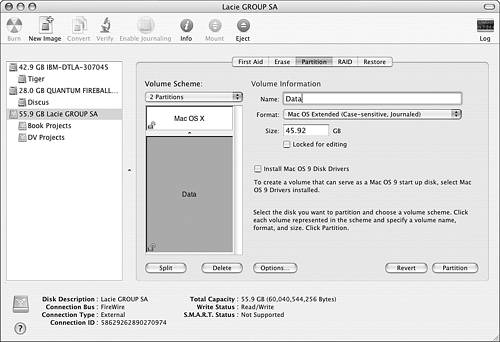
CAUTION Partitioning a drive erases all the data on it. If the drive has data on it, make sure you back it up before your partition the drive. | 12. | Click Partition. If you will be sharing the drive with non-Apple hardware, such as a Windows computer, click the Options button, choose PC Partition Scheme, and click OK.
| 13. | If you are sure that you want to initialize and partition the drive, click Partition in the Warning sheet. You will return to the Disk Utility window and a progress bar will appear in the lower right corner of the window. You can use this to monitor the process.
| 14. | When the process is complete, select the drive you partitioned. Confirm that the drive has been partitioned properly (see Figure 31.6).
Figure 31.6. The selected drive now has a relatively small partition for a Mac OS X installation and a larger one for data storage. 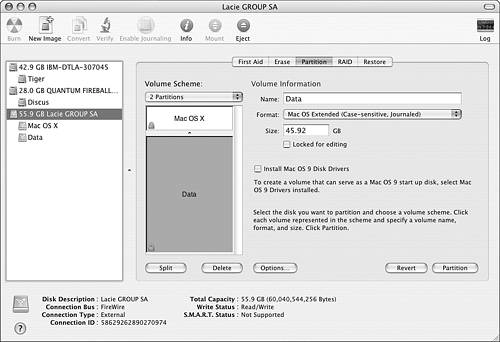
| 15. | Under the hard drive icon, select one of the partitions you just created. The Information pane at the bottom of the window will reveal details about that partition, such as the format, capacity, available space (which will be about the same as capacity immediately after you partition a drive), and so on.
| 16. | Explore each partition to ensure that they are configured properly.
| 17. | Quit Disk Utility.
|
When you return to your desktop, you will see the new volumes that are ready for your data (see Figure 31.7). Figure 31.7. The Mac OS X and Data volumes are ready to use. 
 | Disk Utility can't see your new drive? See "Disk Utility Can't See My Drive" in the "Troubleshooting" section at the end of this chapter. |
You can also use Disk Utility for various other tasks, such as erasing a disk or a volume, managing disk images, disk maintenance, and creating a RAID disk.  To learn how to use Disk Utility for disk maintenance tasks, p. 1000. To learn how to use Disk Utility for disk maintenance tasks, p. 1000.
|


 To learn about the various interfaces related to hard drives,
To learn about the various interfaces related to hard drives, 



